Superlative Six - 1929 Hudson Super Six
Six is greater than eight, as proven by the outstanding engineering on this 1929 Hudson Super Six sedan
09/24/2018
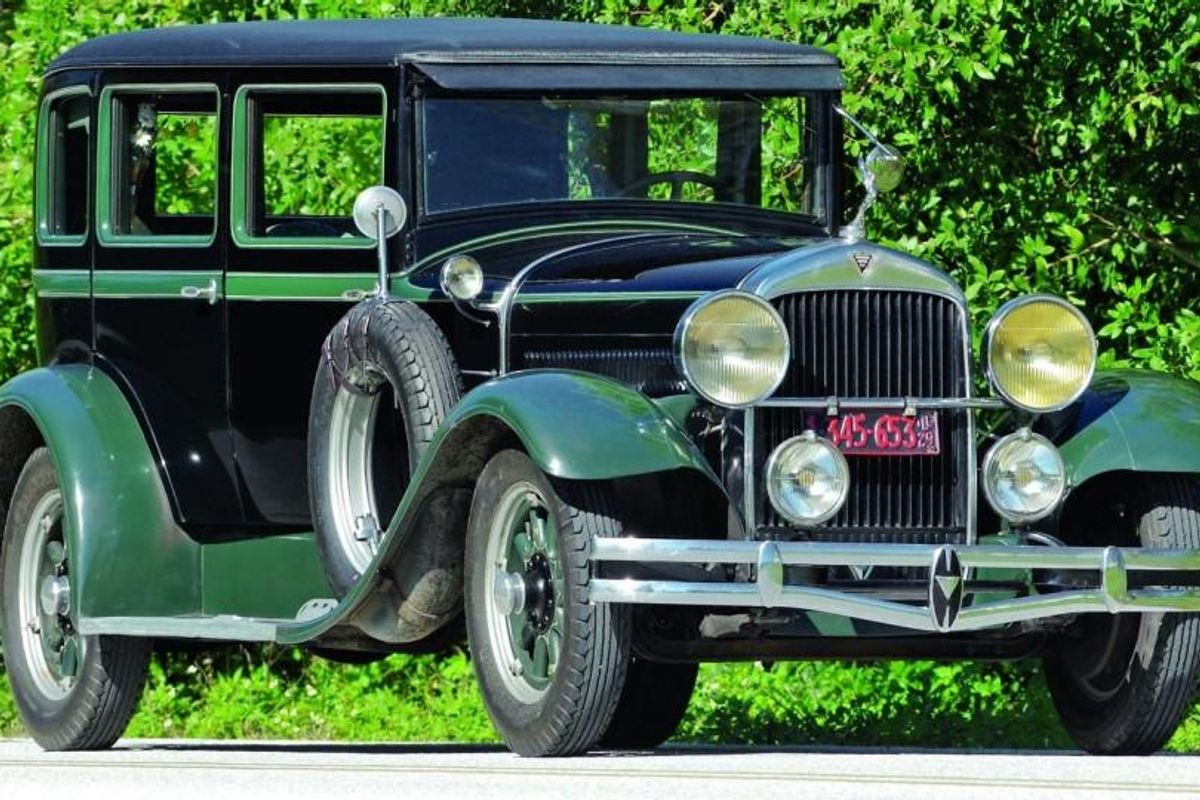

Stylistically, early sedans are largely fungible. It's in their mechanical attributes where they stand apart. Hudson's six-cylinder engine was always a step beyond the industry standard. When first introduced, the "Super Six" was balanced for high-speed running. Later, when the companion Essex brand dropped its F-head four-cylinder for a flathead-six, the Super Six gained an F-head for itself. In 1927, that six was a technological marvel more than equal to anything in its price range.
That sophistication and its attendant power is why Dave Lanning of Englewood, Florida, sought out the well-preserved example you see on these pages. "These were the Chrysler Hemis of their day, and just as complicated and expensive to build," Dave proudly tells us regarding the engine's intake-over-exhaust cylinder head design. "It's not real fast because it's geared so low, but you can feel the power. I knew I wanted a 1927, '28 or '29 model with the F-head engine."
The public also wanted that F-head, as 1929 was Hudson's best sales year ever, with a combined figure (including Essex) of over 300,000 cars produced, which propelled the company to third place in the industry. In 1930, however, the F-head was gone and in its place was an L-head straight-eight derived from the Essex engine--arguably it was a more prestigious configuration than a six, but it failed to capture sales.
Dave has had later Hudsons with the straight-eight and has experienced a contemporary Packard Eight sedan. But he says that neither makes a better touring car than the 288-cu.in., 92hp, F-head straight-six with its intake valves actuated by pushrods and its exhaust valves riding in the block like a flathead. "It's quite a powerful car," he tells us. "I had an eight-cylinder speedster, and this is more powerful than that. I prefer the Hudson to the Packard. That F-head is a great engine, very smooth and easy to work on."
Even Hudson recognized the superiority of the F-head Super Six versus the likes of Packard, boasting in a 1928 advertisement that the Super Six possessed "Performance that even higher price can't buy." The 1929 iteration of the Super Six was fully refined with a 6.0:1 compression ratio and an accelerator pump in its Marvel carburetor, both of which must have added considerably to the Hudson's driving manners.
Dave says he didn't necessarily go looking for a survivor, but when he discovered this driveable dream with only 40,000 miles on the odometer through a friend in the Hudson club who was more interested in the 1950s "step-down" cars than Hudson's heyday in the 1920s, it didn't take Dave much deliberation. He loaded his 1924 Dodge touring car, which had been in his collection for nearly half a century, on a trailer, sold it in nearby Clearwater and continued north to where this pristine sedan awaited.
"I think it's all original other than the tires and the fan belt," he says. And, of course, it has new spark plug wires made by Dave from a spool of NOS cloth wire he bought years ago. A previous owner also replaced the outer layer of the top insert with original material after a mishap attempting to load the tall sedan into a slightly undersized trailer.
"It had a real, real easy life," Dave speculates. He reports that when it entered his possession, all it needed to return to service was a change of fluids and for him to free up one stuck valve. Since then, the Hudson has been in regular rotation with the rest of Dave's 14-car collection, taking tours and attending car shows.
Dave says the Hudson's condition overall complements the power of the impressive F-head straight-six, with a tight chassis, smooth shifting from the cork-faced, wet clutch and outstanding stopping ability from the four-wheel cable-actuated drum brakes. Back in 1929, Hudson boasted the Super Six was capable of more than 80 MPH and would cruise at "70 miles per hour all day." Dave prefers a more sedate pace, topping out at about 50 MPH--still more than adequate for driving around town. "Stopping is wonderful," he says, "This is the one car I really don't worry about in local traffic."
The Hudson's original mohair interior, designed for owner operation rather than chauffeur service like some contemporary makes of similar size, makes for easy driving as well. Although, Dave points out that an outsized previous owner relocated the tracks of the adjustable seat a couple inches rearward for extra leg room and he intends to return them to their original location. Also, the original "Parabeam" headlamps are somewhat underwhelming on their own, but Dave has found that using the original driving lamps in conjunction makes for excellent illumination during night drives.
Because the Hudson is such a comfortable and worry-free car, Dave says he drives it at least every other week, and around 1,000 miles annually. He particularly enjoys showing it off at local gatherings where it makes a striking contrast to cars 30 or 40 years newer; it really attracts attention when he lifts the hood, showing off the unusual cylinder head design.
Even where the old Hudson exhibits wear, the damage arguably contributes to its overall charm. The mechanical clock mounted near the headliner, for example, requires occasional winding. Over the course of almost 90 years the fingers of various owners have worn a hole in the cloth while performing that task. Dave notes it lends a kind of kinship with the car's history to feel his own fingers fall into those grooves while turning the crown of the old chronometer.
That kind of enjoyment and driving are all that the future has in store for this Super Six. Dave carefully maintains its original finish with Meguiars products and picks up spare parts here and there when the opportunity arises. He feels no real dread about keeping the car in good repair, however, as Hudson's popularity when new means spares are relatively easy to come by even today.
"The only thing I have to do," Dave says of mechanical maintenance, "is at least every 400 or 500 miles, there's little oilers on top of the intake valves to lubricate the valve stems. Just put some oil in there, and that's it."
Forget Ford’s groundbreaking electric truck for a moment to consider this 2001 Ford SVT F-150 Lightning now offered on Hemmings Auctions. Instead of the dual permanent-magnet motors found in the current electric Lightning, the 1999-2004 SVT Lightning featured a supercharged version of Ford’s 5.4-liter “modular” OHC V8. Rated at 380 horsepower in the 2001-’04 models, it was good enough to make a stock lightning a formidable opponent on the street as well as at the strip.
A follow-up to the original 1993-’95 F-150 Lightning, which was a high-performance version of a standard F-150, the second-generation SVT super truck presented as a more thoroughly developed model with a lot more exclusive components that further differentiated it from the rest of the F-Series lineup. Beyond the engine, the entire suspension and braking system, not to mention aerodynamic body add-ons, were part of the Lightning package from 1999 through 2004. Exclusive interior components were also part of the package.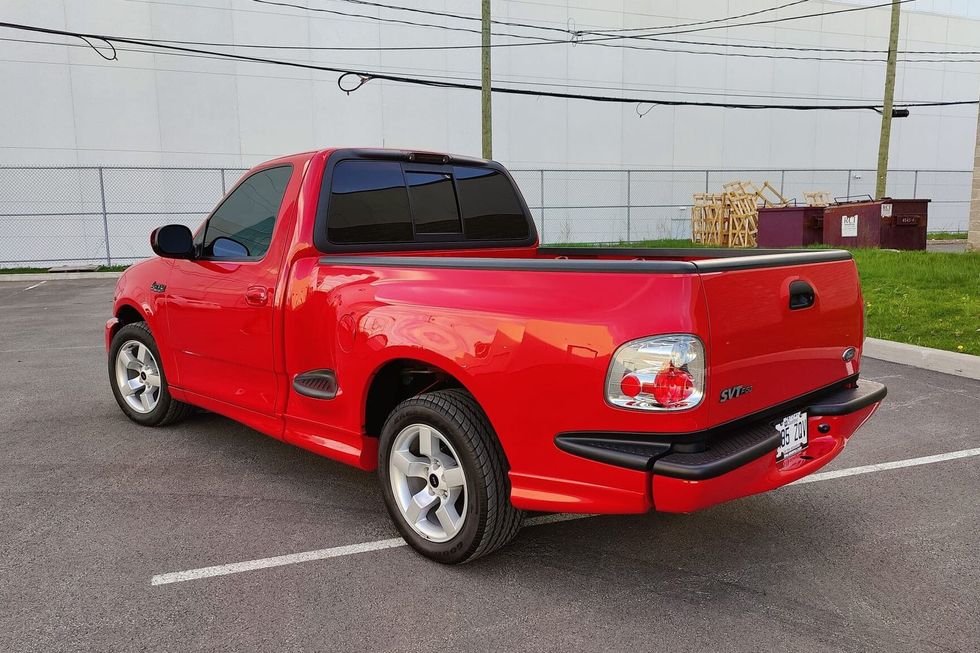
At the heart of this SVT Lightning is its iron-block 5.4-liter SOHC, 16-valve V8 with a supercharger and an intercooler. The blower helped it deliver 380 horsepower and 450 lb-ft of torque in 2001, up some 20 horsepower and 10 lb-ft from the ’99 and 2000 models. The Eaton supercharged engine delivered peak boost of 8.0 psi and the engine featured an 8.4:1 static compression ratio, down from the standard 5.4 V8’s 9.0:1, which was rated at 260 horsepower and 350 lb-ft.
Power reached the rear 18-inch cast aluminum-alloy wheels via a four-speed automatic, an aluminum driveshaft and a beefy 9.75-inch, limited-slip rear axle with an acceleration-friendly 3.73:1 final-drive ratio, another upgrade for 2001. Car and Driver magazine reported a 0-60 mph time of 5.2 seconds and a quarter-mile in an E.T. of 13.8 seconds at 104 mph—impressive numbers for a 4,600-pound truck. Top speed was a drag-limited 142 mph.
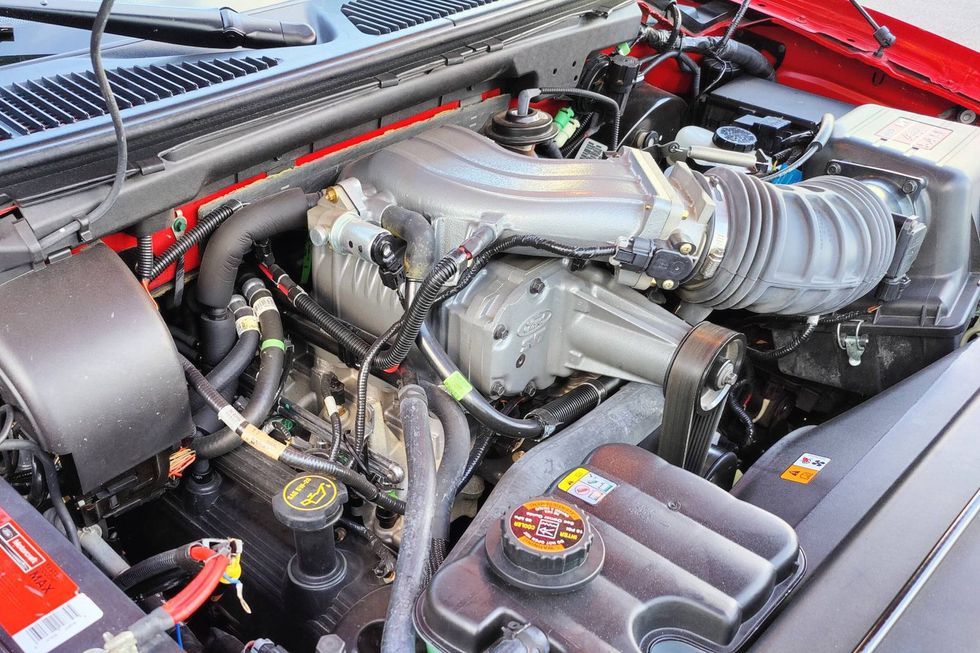
Trucks generally require a suspension that can handle a full load in its bed while also providing competent driving while empty. But if you fancy one designed to a sports-car standard, then something has to give. In the case of the second-gen Lightning, Ford dropped its payload capacity to a mere 800 pounds. A standard 2001 F-150 Styleside carried a 3,180-pound payload rating, while an F-150 Flareside was rated at 2,005 pounds, some two-and-a-half times the Lightning, which featured the short-bed Flareside body. Towing capacity, likewise, was reduced from 8,800 pounds to 5,000 in the Lightning. But the Lightning’s strengths were never its payload or towing capacities, but it’s ability to perform like a sports car.
As a 21st century performance vehicle, however, the second-gen Lightning was also equipped to handle. A half-inch drop at the front was accompanied by SVT-specific coil springs and Bilstein shocks along with an exclusive 31-mm solid anti-roll bar. SVT’s influence continued at the rear with Lightning-specific five-leaf springs and a 23-mm solid anti-roll bar. The Bilstein setup at the rear included the right-rear shock staggered toward the front of the truck to reduce axle hop under heavy acceleration. The four-wheel antilock disc brakes were cribbed from the three-quarter-ton F-250, with 12.1-inch front rotors at the front and 13.1-inch discs at the rear.
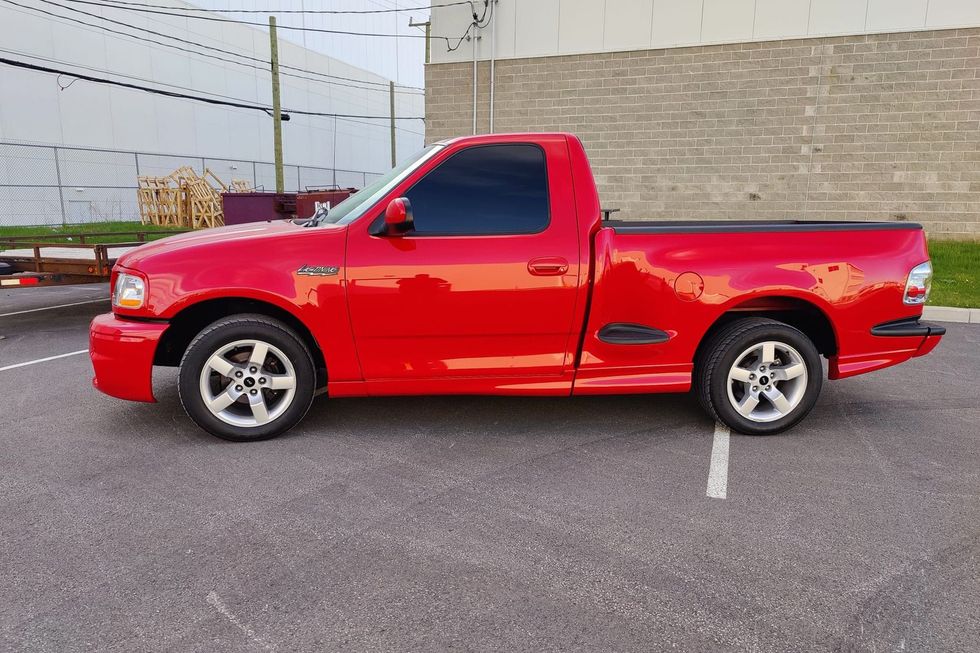
As the years go on, fewer and fewer clean, unmolested low-mileage examples are out there, which is why this 2001 Ford SVT F150 Lightning now on Hemmings Auctions caught our attention. Showing just 5,525.5 miles on its odometer at the time of submission, it is said to be in “mint” condition and have an “immaculate” finish in the seller’s words. No modifications are noted to any part of the vehicle. The 18-inch factory alloys don’t appear to have any curb rash, though the Goodyear performance tires may be original. About the only deviations from stock are the tinted windows.
The latest electric-only F-150 Lightning is certainly a quick vehicle in its own right, but this 2001 edition from the engineers at SVT was built for excitement, not range. It was made with an old-school muscle-car vibe along with modern handling and braking. Which Lightning would you look good behind the wheel of?
Take a look at this second-gen Lightning on Hemmings Auctions before the bidding ends.
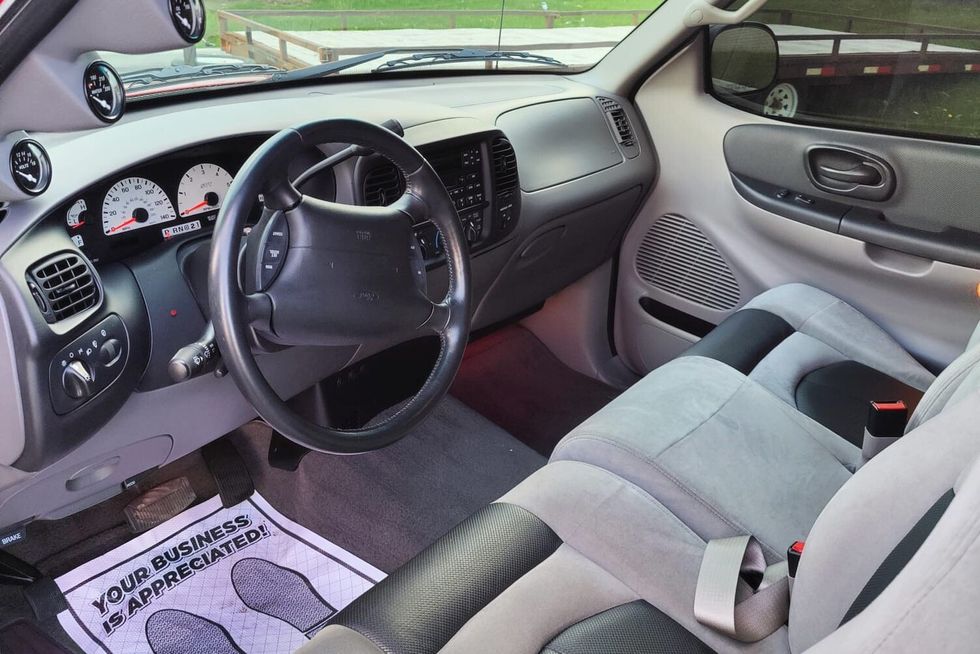
Spring is here. As the snow melts and the daffodils bloom, it’s time for many vintage cars to emerge from winter hibernation and get back on the road. Thinking of adding to the collection? We have 10 vehicles in spring-like shades of yellow – including cars and trucks, U.S. and European – to catch your eye.

















































